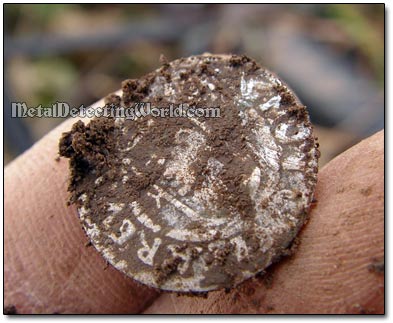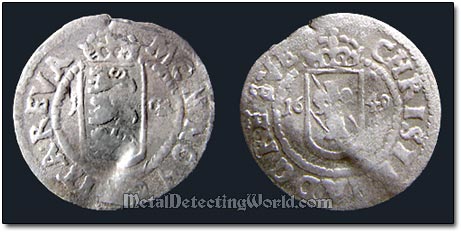Part I - Metal Detecting at the Swedish Tavern Site, page 23
Unearthing Livonian Silver 1 Íre Coin Minted in Reval
...It was getting better and better! I received an "iron nail" signal with a few "pull-tab" beeps at the end. Now I was getting exciting! I broke the dirt plug in half, and there it was - a silver hammered coin - "No way!"

Now I was fully enjoying my E-Trac's field-test!

I could clearly see the letters "CHRISTINA" and the coat of arms of Vasa family - a sheaf, on the obverse. It was definitely a coin struck under the Swedish rule...

...But this coin was not struck in Sweden - the coat of arms depicting three leopards on the coin's reverse was an indication of that. Later I found out that the three leopards were placed on coins struck in Reval (now Tallinn) during the Swedish occupation of Estonia.

I identified the coin as a silver 1649 1 Öre minted in Reval during the reign of Queen Christina.
Swedish-Estonian Silver 1649 1 Öre, Queen Christina

OBVERSE: Sheaf on shield below crown, divide date 1649 in circle, legend: CHRISTINA.D.G.RE.SVE
REVERSE: 3 leopards in shield below crown, divide value 1ör, legend: MON. NOV. REVA
COIN DIAMETER: 18mm
COIN WEIGHT: 0,94g
SILVER CONTENT: Ag 250/1000 (.250)
MINT: Reval
Öre coin denomination - brief historical facts:
During the middle ages, the Öre was a unit of Swedish currency equal to 1/8 of a Mark, 3 Örtugar or either 24, 36 or 48 Penningar (depending on the geographical area in which it was used). It was used as a counting unit for currency already in the 11th century, but was not minted until 1522. The first Öre coins were struck during the reign of King Gustav Vasa (Wasa) of Sweden in 1552. Also the coins of the following denominations were minted: 2 Öre (coins of round and square shapes), and 4, 8, 12, 15 and 16 Öre - all of a square shape, and 4, 8, 16 Öre - all of a rhomboid shape.
The Öre was withdrawn in 1776, but returned in 1855 as 1/100 of the Riksdaler. The Riksdaler was replace by Krona in 1873 (one Riksdaler equalling one Krona in the exchange), but Öre remained the name of the subdivision of the currency. Since 1991, the only coin in use with a value below 1 Swedish Krona (SEK) is the 50 Öre coin. On December 18, 2008, the Swedish Riksbank announced a recommendation to the Swedish government to phase out the final Öre coin by 2010. As of March 25, 2009, the coin is no longer minted.